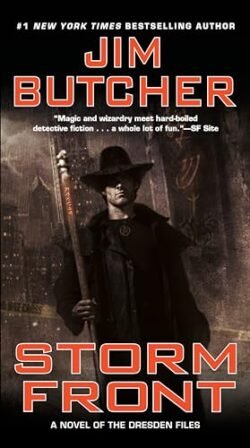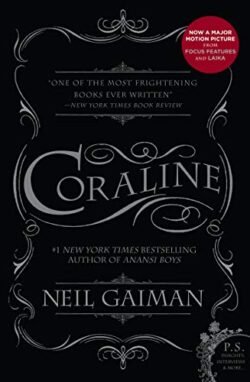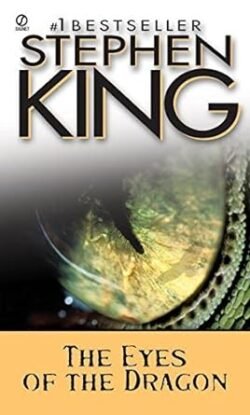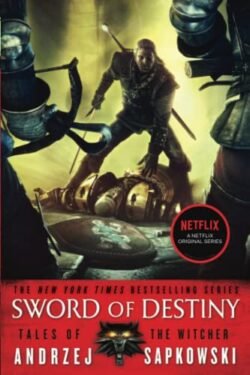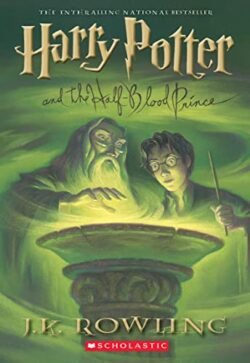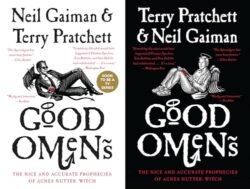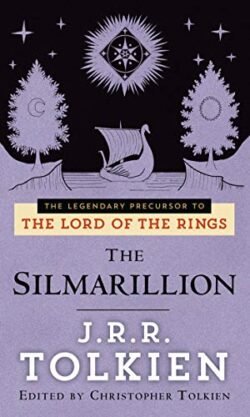“Storm Front” by Jim Butcher, published in 2000, is the first novel in the Dresden Files series. It introduces readers to Harry Dresden, the only wizard listed in the Chicago phone book and a private investigator who consults for the police department on cases involving the supernatural. In “Storm Front,” Dresden is called to investigate a series of brutal murders that appear to be executed with black magic, leading him into the heart of Chicago’s occult underworld. As Dresden tries to solve the case, he navigates a dangerous world of mobsters, vampires, and other magical beings, all while dealing with the White Council of Wizards, which oversees the practices of magic and does not look kindly on those who break the rules. Dresden must use all his wits and magical skills to solve the murders without breaking the laws of magic or becoming the killer’s next victim. Character Analysis Harry Dresden: Harry Dresden is characterized by his sharp wit, strong moral compass, and deep sense of duty to protect the innocent. Despite his often cynical outlook, Dresden’s inherent goodness and willingness to risk his life for others define his role as a hero in the series. Themes and Analysis The Intersection of the Mundane and Magical: “Storm Front” explores the coexistence of the everyday world with the supernatural, examining how these realms intersect and affect each other. Moral Ambiguity and Ethical Choices: Dresden’s navigation of complex moral landscapes, especially regarding the use of magic, highlights themes of responsibility and the consequences of one’s actions. Isolation and Community: Dresden’s isolation from both the mundane and magical communities, coupled with his connections to a few key allies, speaks to themes of loneliness, friendship, and the importance of finding one’s place in the world. “Storm Front” sets the stage for the Dresden Files series with its compelling mix of detective noir and urban fantasy. Jim Butcher creates a richly imagined world where magic is real but hidden, and the protagonist, Harry Dresden, stands at the crossroads of the human and supernatural worlds. The novel not only offers a thrilling mystery but also introduces a complex hero whose adventures will continue to explore the depths of magic, power, and the human spirit. If the summary caught your interest, Consider reading the full book on AbeBooks. Explore this book on AbeBooks
Coraline
“Coraline” by Neil Gaiman, first published in 2002, is a dark fantasy novel that has captivated readers of all ages with its imaginative storytelling and haunting atmosphere. The story follows Coraline Jones, a young girl who discovers a secret door in her new home that leads to an alternate universe. This other world initially seems like a better version of her own, with attentive parents and exciting discoveries. However, Coraline soon realizes that this parallel place harbors dark secrets and sinister intentions, particularly in the form of the Other Mother, a malevolent entity who wants to keep Coraline forever. As Coraline courageously fights to save herself and other trapped souls, the novel explores themes of bravery, the importance of self-identity, and the meaning of home. Gaiman’s rich prose and the story’s eerie undertones make “Coraline” a compelling read that challenges the boundaries between the whimsical and the macabre. Character Analysis Coraline Jones: Coraline is portrayed as an adventurous, curious, and remarkably brave girl. Her journey in the novel highlights her growth from feeling neglected and bored to discovering her inner strength and the value of appreciating her own reality. The Other Mother: The Other Mother, also known as the Beldam, is the antagonist of the story. She is a shape-shifting entity that lures children into her world to trap them. Her character embodies themes of manipulation and the deceptive allure of seemingly perfect worlds. Themes and Analysis Courage and Resourcefulness: “Coraline” celebrates the protagonist’s bravery and ingenuity as she confronts fears and challenges far beyond her years. The Illusion of Perfection: The novel critiques the pursuit of a flawless existence, showcasing the dangers of being seduced by superficially ideal alternatives to the complexities of real life. The Power of Free Will: Coraline’s ability to make choices, question her surroundings, and reject the Other Mother’s manipulations is central to the narrative, underscoring the importance of autonomy and self-determination. Neil Gaiman’s “Coraline” is a modern classic that blends fairy tale elements with psychological horror to create a uniquely captivating story. Its success lies not only in its ability to entertain and frighten but also in its profound exploration of what it means to face one’s fears and appreciate the often imperfect beauty of one’s own world. The novel’s enduring appeal is evidenced by its adaptation into various other media, including a critically acclaimed stop-motion film, ensuring that Coraline’s tale continues to enchant and inspire new generations of readers and viewers. If the summary caught your interest, Consider reading the full book on AbeBooks. Explore this book on AbeBooks
The Eyes of the Dragon
“The Eyes of the Dragon” by Stephen King, published in 1987, marks a departure from the author’s usual horror genre, delving instead into the realm of fantasy and adventure. Set in the fictional realm of Delain, part of King’s larger multiverse, the novel tells the story of a kingdom thrown into chaos by the machinations of a malevolent wizard named Flagg. The plot centers around two princes, Peter and Thomas, who are the sons of King Roland. After the king’s mysterious death, which is secretly orchestrated by Flagg, the elder prince, Peter, is wrongfully imprisoned for the murder, leaving the younger and more impressionable Thomas to ascend the throne under Flagg’s sinister influence. The narrative unfolds as a classic tale of good versus evil, with young Peter’s journey to prove his innocence and reclaim his rightful place on the throne, aided by a loyal group of friends and the mysterious powers of a magical artifact known as “the eyes of the dragon.” Character Analysis Peter: Peter, the elder prince, is characterized by his courage, intelligence, and inherent sense of justice. Wrongfully accused and imprisoned, his resilience and determination to reclaim his throne highlight his growth from a boy to a leader. Thomas: Thomas, the younger prince, initially struggles with feelings of inadequacy and jealousy towards his brother. Under Flagg’s influence, he becomes king but is tormented by guilt and doubt, leading to his complex development throughout the story. Flagg: Flagg, the antagonist, is a dark and manipulative wizard whose ultimate goal is to bring ruin to Delain. His character embodies the archetypal evil sorcerer, using deceit and dark magic to achieve his ends. Themes and Analysis The Battle Between Good and Evil: The novel explores the timeless theme of good versus evil, embodied in the conflict between Peter and Flagg. The Journey of Maturation: Through the trials they face, both Peter and Thomas undergo significant personal growth, highlighting themes of maturity, responsibility, and the search for one’s identity. Power and Corruption: “The Eyes of the Dragon” delves into how power can corrupt, as seen through Thomas’s struggles as king and Flagg’s manipulations to gain control of the kingdom. “The Eyes of the Dragon” stands out as a unique entry in Stephen King’s bibliography, offering readers a richly crafted fantasy world filled with intrigue, magic, and the struggle for power. Its departure from horror showcases King’s versatility as a storyteller, weaving a tale that is as much about the characters’ internal journeys as it is about their external adventures. With its engaging plot, complex characters, and exploration of universal themes, the novel is a compelling read for both fans of Stephen King and lovers of fantasy fiction alike. If the summary caught your interest, Consider reading the full book on AbeBooks. Explore this book on AbeBooks
Sword of Destiny (The Witcher)
“Sword of Destiny” is the second book in “The Witcher” series by Polish author Andrzej Sapkowski, first published in 1992. It is a collection of six short stories that further explore the adventures of Geralt of Rivia, a Witcher with supernatural abilities who hunts monsters for a living. The stories delve into Geralt’s complex relationships, moral dilemmas, and the destiny that binds him to Ciri, a child of prophecy who holds the power to change the world. Through these narratives, Sapkowski expands the richly detailed universe of “The Witcher,” blending elements of Slavic mythology, traditional fantasy, and philosophical reflection. Themes and Analysis Geralt of Rivia: Geralt is a Witcher, a monster hunter who has undergone extensive training and magical enhancements. Known for his prowess in combat and his signature white hair, Geralt is a morally complex character, often caught between the lesser of two evils. His stoic exterior belies a deep sense of ethics and a conflicted heart, as he navigates a world where humans can be more monstrous than the creatures he hunts. Themes and Analysis Destiny and Choice: A recurring theme in “Sword of Destiny” is the interplay between destiny and free will. Geralt’s skepticism of destiny is challenged as he encounters individuals and events that suggest his fate is intertwined with Ciri’s. Nature of Humanity: Sapkowski uses the backdrop of a fantasy world to explore the nature of humanity, examining themes of prejudice, love, and the capacity for both kindness and cruelty. Environmentalism and Balance: Several stories in the collection touch on the relationship between humans and the natural world, highlighting the consequences of environmental degradation and the importance of maintaining balance. “Sword of Destiny” is a critical work in “The Witcher” series, providing key background and depth to the saga’s central characters and themes. Andrzej Sapkowski’s storytelling is both engaging and thought-provoking, offering readers a blend of action, intrigue, and philosophical musing. The collection is essential reading for fans of “The Witcher,” providing a deeper understanding of Geralt’s world and the forces that shape his destiny. As part of a beloved fantasy series, “Sword of Destiny” stands out for its rich character development, moral complexity, and its exploration of timeless themes through the lens of a meticulously crafted fantasy universe. If the summary caught your interest, Consider reading the full book on AbeBooks. Explore this book on AbeBooks
Harry Potter and the Half-Blood Prince
“Harry Potter and the Half-Blood Prince,” the sixth book in J.K. Rowling’s beloved Harry Potter series, delves deeper into the magical world’s dark side as Harry Potter embarks on his sixth year at Hogwarts School of Witchcraft and Wizardry. The novel explores themes of love, loyalty, and the sacrifices required to combat evil. As Voldemort’s power grows stronger, Harry discovers an old potions textbook belonging to the mysterious “Half-Blood Prince,” which leads him on a journey filled with danger, mystery, and significant revelations about Lord Voldemort’s past and his connection to Harry. Character Analysis Harry Potter: Now more mature and facing the realities of the impending battle against Voldemort, Harry takes on the responsibility of learning as much as he can about his enemy. His discovery of the Half-Blood Prince’s textbook reveals not only helpful potions tips but also darker magic that tempts Harry in his quest for the truth. Albus Dumbledore: Dumbledore takes on a more central role, guiding Harry through memories of Voldemort’s past to uncover his weaknesses. This mentorship deepens their relationship, showcasing Dumbledore’s trust in Harry and his wisdom in preparing Harry for the challenges ahead. Severus Snape: Snape’s allegiance becomes more complex, as he makes an unbreakable vow to protect Draco Malfoy and fulfill a task assigned by Voldemort. His role as the Half-Blood Prince and his actions towards the end of the novel leave readers questioning his true intentions. Themes and Analysis The Complexity of Good and Evil: The novel explores the nuanced nature of characters, revealing the complexity of their motivations and challenging the notion of pure good versus pure evil. Sacrifice and Loss: As the wizarding world braces for war, themes of sacrifice and the pain of loss are prominent, highlighting the characters’ courage and resilience. The Power of Love: Love emerges as a powerful force, offering protection and motivating characters to make significant sacrifices. The revelations about Voldemort’s past and his inability to understand love underscore its significance in the battle against darkness. “Harry Potter and the Half-Blood Prince” is a pivotal installment in the Harry Potter series, setting the stage for the final confrontation with Voldemort. J.K. Rowling skillfully weaves a tale of mystery, love, and betrayal, deepening the reader’s understanding of the magical world and its characters. The novel’s exploration of themes such as the cost of power, the importance of choices, and the enduring strength of love adds depth to the series’ larger narrative. As Harry prepares for the ultimate battle, readers are left contemplating the sacrifices required to face evil and the power of love as humanity’s greatest weapon. If the summary caught your interest, Consider reading the full book on AbeBooks. Explore this book on AbeBooks
Good Omens
“Good Omens” by Neil Gaiman and Terry Pratchett is a comedic yet profound novel about the apocalypse. The story centers on an angel, Aziraphale, and a demon, Crowley, who have grown quite fond of Earth and its inhabitants after spending thousands of years among them. With the arrival of the Antichrist and the impending end of the world, they join forces in an unlikely alliance to prevent Armageddon. Along the way, they encounter a diverse cast of characters, including witch hunters, modern-day witches, and the Four Horsemen of the Apocalypse, each playing a role in the lead-up to the final battle between Heaven and Hell. “Good Omens” combines wit, satire, and deep insights into human nature, exploring themes of good versus evil, fate versus free will, and the complex nature of humanity. Character Analysis Aziraphale: Aziraphale, an angel who doubles as a rare book dealer, is characterized by his love for humanity’s cultural achievements and a somewhat fussy righteousness. His deep friendship with Crowley is built on centuries of shared experiences, and despite their opposing natures, he is determined to save the world from destruction. Crowley: Crowley, a demon with a penchant for fast cars and a somewhat relaxed attitude towards evil, is not as bad as he’s supposed to be. His affection for Earth and its pleasures makes him question the necessity of the apocalypse. His innovative thinking and deep bond with Aziraphale drive much of the novel’s plot. Themes and Analysis The Nature of Good and Evil: The novel playfully explores the gray areas between good and evil, suggesting that individuals are capable of both, regardless of their celestial or infernal origins. Fate vs. Free Will: “Good Omens” questions the notion of predetermined fate, emphasizing the importance of free will and the ability of individuals to influence the future. Humanity’s Complexity: Through its diverse cast of characters, the novel celebrates the complexities and idiosyncrasies of human life, highlighting both the virtues and vices that define humanity. “Good Omens” is a masterful blend of humor, fantasy, and insightful commentary on the human condition. Neil Gaiman and Terry Pratchett have created a world where the line between good and evil is blurred, and the impending apocalypse serves as a backdrop to examine deeper philosophical questions. The novel’s enduring appeal lies in its clever subversion of biblical and apocalyptic tropes, memorable characters, and the ultimate message that humanity, for all its flaws, is worth saving. As a satirical take on the end of the world, “Good Omens” offers readers laughter, suspense, and a heartfelt examination of what it means to be human. If the summary caught your interest, Consider reading the full book on AbeBooks. Explore this book on AbeBooks
The Silmarillion: The legendary precursor to The Lord of the Rings
“The Silmarillion” by J.R.R. Tolkien, edited and published posthumously by his son Christopher Tolkien, is a monumental work of mythology that lays the foundation for the Middle-earth universe, setting the stage for “The Hobbit” and “The Lord of the Rings.” This collection of mythopoeic stories delves into the creation of the world, the rise and fall of its first peoples, the Elves and Men, and the epic tales of heroism, betrayal, and tragedy that define the ancient history of Middle-earth. “The Silmarillion” is not just a prelude to Tolkien’s more famous works but a rich, complex tapestry of lore and legend that offers readers a deeper understanding of his mythical world. Character Analysis While “The Silmarillion” encompasses a vast array of characters, a few key figures stand out for their significant roles in the narrative: Ilúvatar (Eru): Ilúvatar, or Eru, is the supreme deity who creates the universe and the Ainur, powerful spiritual beings, through his thought and music. His character represents the ultimate source of all creation and authority in Tolkien’s universe, embodying themes of divinity, fate, and free will. Melkor (Morgoth): Melkor, later known as Morgoth, is the first and most powerful of the Ainur created by Ilúvatar. His rebellion and desire to dominate and corrupt Middle-earth make him the primary antagonist. Melkor’s character explores themes of pride, envy, and the nature of evil. Fëanor: Fëanor is a pivotal Elf character, renowned for his craftsmanship and the creation of the Silmarils, three jewels of immense beauty and power. His oath to recover the Silmarils, which are stolen by Morgoth, sets off a chain of events marked by heroism and tragedy. Fëanor’s character delves into themes of obsession, loyalty, and the consequences of vengeance. Themes and Analysis Creation and Myth: “The Silmarillion” establishes the mythology of Middle-earth, exploring themes of creation, divine intervention, and the struggles between good and evil. Fate and Free Will: The narrative examines the tension between the predestined fate of the world and the characters’ free will, particularly in their capacity to resist or succumb to evil. Loss and Redemption: Throughout the stories, themes of loss, the pursuit of beauty and perfection, and the possibility of redemption resonate, reflecting the complexity of the moral and spiritual landscape of Middle-earth. “The Silmarillion” is a masterful work that enriches the lore of Middle-earth and deepens the reader’s appreciation for J.R.R. Tolkien’s imaginative world. Its tales of creation, divine drama, and the heroic sagas of Elves and Men offer a profound exploration of themes that resonate with human experience. This collection stands as a testament to Tolkien’s unparalleled skill in world-building and myth-making, inviting readers to lose themselves in the ancient history that underpins the beloved stories of “The Hobbit” and “The Lord of the Rings.” “The Silmarillion” is not only a prelude to these works but a monumental achievement in its own right, capturing the heart and soul of Tolkien’s legendarium. If the summary caught your interest, Consider reading the full book on AbeBooks. Explore this book on AbeBooks

